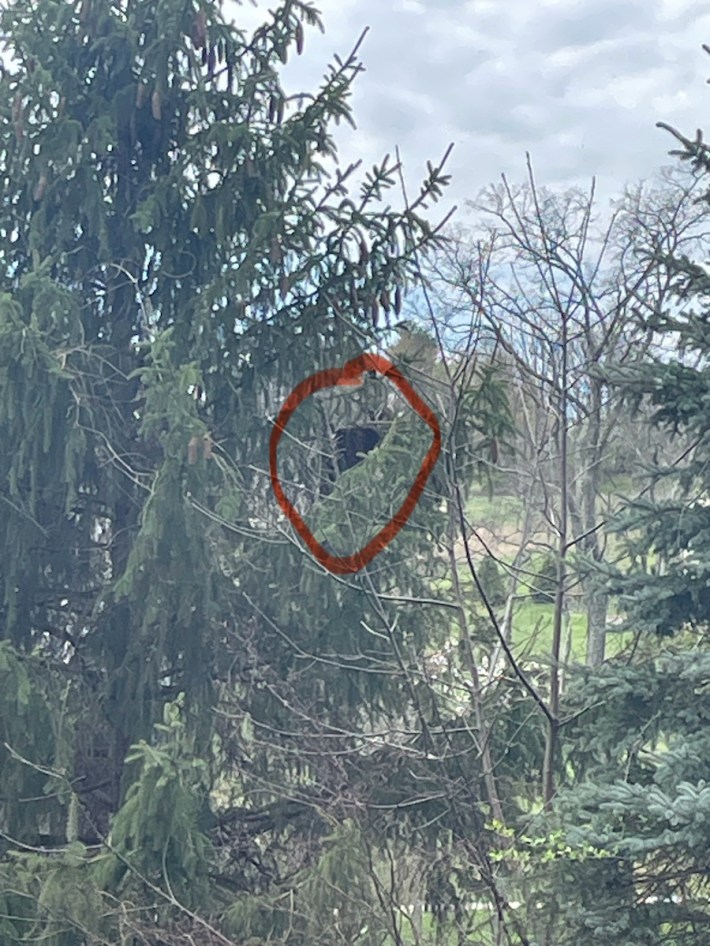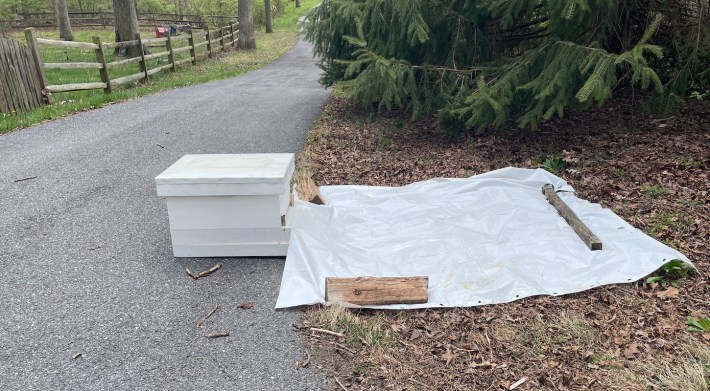Around 11:30 on Monday morning I realized that I'd been listening to a crescendoing buzzing sound off to my right for some length of time.
Monday was the first day I took my laptop outside to work on the porch this spring; until I noticed the buzzing I'd been idly scanning the news and goofing off in Slack while the Merlin app on my phone sorted through the morning's absolute riot of birdsong. Springtime stuff. Now I had the thought that maybe the neighbor's outdoor air-conditioning unit was, like, malfunctioning. Or that an electrical motor was revving very high? But that wasn't right; this was not a mechanical sound. The buzzing was very loud and getting louder, and it was also somehow large. It occupied a lot of space. I stood up and took a few steps to look around the blue Atlas cedar to my right, and my eyes and brain did the weird chain-link fence thing where they couldn't judge the distance of what they were looking at and I had to blink a bunch. After a moment my various systems got their respective shit together, and I discovered that I was looking across the driveway at the largest, loudest, and most visibly furious swarm of flying insects I've ever seen in my life. It was a cloud. I've never seen anything like it.
Because I live in a log cabin only occasionally not doubling as either the dinner or tunneling medium of this or that destructive insect species—damn you to hell, carpenter bees—my thoughts immediately ran to termites. Do termites swarm? I have no idea whether termites swarm. If ever they did swarm, my house would absolutely be where they'd do it. I walked cautiously across the driveway. What was I going to do if these were termites? Wave a towel at them? Flail my arms and gibber incoherently? Calmly retreat across the driveway, and burn my own house down?
They were not termites! They were very small honeybees. Occasionally one would touch down on a tree sprig long enough for me to get a brief look. Their numbers were impossible. I had never seen that many of any living thing. The noise was gigantic, like when military helicopters fly overhead. My phone's video camera was not remotely up to the task of capturing any of it.
As I made my way around the line of ragged trees and impenetrable bramble that separates my weird log home from the newer and very normal suburban sub-development next door, I saw an incredible thing. The bees were massing on a branch of one of the ragged evergreens, some 16 feet off the ground: As I watched, they formed a huge stalactite of bees. With what seemed like thousands of them still circulating in a cloud around the tree, the stalactite was already shockingly large, comparable in length and thickness to, say, a grown man's upper leg. Maddeningly, I could only photograph it from below, with the bright midday sky above, with my phone's inadequate camera. This is why it looks like an indistinct black lump. But that is bees.

Here's another video:
On the one hand, the discovery that this was a swarm of honeybees was a great relief. Honeybees will not eat my house, for one thing. For another, honeybees are Good: important pollinators, and makers of honey, and fascinating and complex social creatures, and extremely cute. To see roughly one zillion of them, this loud and impossible number of them, busily doing Bee Stuff, made me want to jump around and cheer.
But also, they were close enough for me to feel responsible for them. What if they needed something from me? What if, when they moved on from this tree, they couldn't find a good place to go, and wound up having to split up and wander the United States in search of work individually, like a Dust Bowl family scattered by poverty? What if because of my inaction they became one zillion sad and lost bee hobos instead of a big happy bee family?
The truth is, I don't know the first thing about what anybody should do when they encounter a swarm of bees, or indeed whether they should do anything at all. I live on the edge of a forested area; maybe these bees would have no trouble finding a good place to make a hive there. But also, maybe while they were on this tree, right on the line dividing my plot from my neighbor's, they would get spooked and swarm one of the neighbor kids—I got swarmed by honeybees inside a hot toolshed when I was 13 and shirtless, and baby that was a bad time—and then the neighbors would get a big can of spray poison and kill the bees. Or maybe, when they moved on from this tree, they would try to build a hive under the eave of my roof, and then unwittingly come into conflict with me; this would be doubly annoying because I'd have had and passed up an opportunity to avert it. Or maybe they would find what seemed a good place to build a hive, and then some bored rural sociopath teen would spray lighter fluid on the hive and burn it; maybe I'd just always wonder whether that happened.
The bee cloud was becalmed; by now most of them had joined the huge mass on the tree branch, with only a few satellite bees buzzing around in the immediate vicinity. I decided to find a Bee Person, while I could, before they moved on again or the tree got struck by lightning. This was surprisingly easy! Maybe it shouldn't have been surprising, given that on both sides of the strip of wooded hills I live on are farm valleys, where there are people who keep bees, as hobbyists or for conservation reasons or because they collect and sell the bees' honey or whatever. There's even a local beekeeping club, turns out. I made one call, and within 10 minutes I'd spoken to three different gracious and friendly and very excited beekeepers; inside of five minutes after that, one of them had dropped everything at his job and rushed home to gather his swarm-collecting gear.
Now it was time for me to second-guess my decision. My new bee friends had massed in an extremely awkward location: High up, for one thing, and directly above thickly clotted hell-brambles that altogether prevented a direct approach on that side of the tree. Also their tree of choice was on significantly sloped ground. What if the well-meaning Bee Guy, hamstrung by these constraints, screwed up somehow? And, like, somehow killed the bees!
The Bee Guy, a mild and kind-eyed elderly guy with a mustache and a bearing that immediately made me think of vegetable gardening, said, "Wow, oh my" when he saw the mass of bees. He went on to explain that, when the beekeepers in the club alert each other to a swarm, they usually communicate the swarm's rough size in sports-ball terms: It's softball-sized, or volleyball-sized, or the really big ones are basketball-sized. This one was far larger than a basketball, and not really much like anything that would or could be used for sports. This one was the size of those humongous lozenge-shaped watermelons they used to sell at supermarkets when I was a kid, which you'd cut into a hundred fan-shaped slices the size of your entire face and an inch thick. It was the size of a slim adult man's upper body. It was, in the Bee Guy's words, "a monster."
This made me feel proud, weirdly? Look at my tree, selected for temporary housing by the mightiest of honeybee swarms! But also, somehow: I am so proud of my bee friends, for how they are thriving.

I watched as the Bee Guy prepared his equipment. He had a white wooden hive box with prepared hive frames neatly slotted inside like cards in a library catalog; some of these had honeycomb already built onto them, presumably left over from previous residents. He set this on the levelest patch of ground he could find anywhere near the tree; in front of its slim slot entrance he laid out a white tarp, which he stapled to the foot of the entrance and pinned down around its edges with logs from my wood pile, so the wind wouldn't blow it around. At various places on and inside the hive box, he applied droplets of some kind of attractant liquid that smelled citric and flowery to me.

He explained how this works: He would collect the bees in a bucket, and then he would dump them out onto the tarp. The bees, he explained, are looking for a place to make a hive, so they don't need much persuading to go inside and check out a box like this one, which for various reasons (including the attractant) they recognize pretty instantly as a good potential hive location. Then they'd signal to each other: Hey, this is a good hive place, everybody get in here. And so the bees would just march in there, from the tarp. It could take a while, but if you waited long enough, all or nearly all of the bees would more-or-less voluntarily, even gladly, make their way into the box!
The part the Bee Guy was concerned about—sensibly—was the "collect the bees in a bucket" part; he agreed with my assessment that the swarm was in just about the most awkward possible location. For this job he hooked what looked like a 3.5-gallon paint bucket to the end of a long, three-part telescoping aluminum pole, like an extremely long broom handle. After he put on the familiar white beekeeping outfit, he took this bucket-and-pole contraption and clambered under and through and over the low branches and brambles around the base of the tree. Then, once he'd gotten more-or-less directly beneath the clumped swarm high above, he extended the pole to its full length and awkwardly snaked it up through the branches of the tree until it was directly under the mass of bees.
I am not ashamed to tell you that by then I had retreated some distance away; I settled for a partly obstructed view of the Bee Guy and the huge bee stalactite. The Bee Guy had a protective suit on. I was wearing work pants and a cheap guayabera shirt.
The next step seemed rough, to me. The Bee Guy kinda jabbed upward with the bucket, jostling the swarm of bees and dislodging a bunch of them. I winced. Many of the dislodged bees took angry flight, as you'd expect—the volume of angry buzzing shot up dramatically—but many more of them simply plopped into the bucket. Then he brought the bucket down—it was maybe one-fifth full, which is still an insane number of bees when you think about it—and carried it over and dumped it out on the tarp, just as he'd said he would. The mass of bees on the tree branch looked no smaller at all, to me.
After a few minutes, my curiosity outgrew my fear of getting stung by a bunch of bees, and I walked over to the box to have a look. A lot of the bees were buzzing around in the air now, and a lot of bees evidently had gone inside the box already, but there were still a lot of bees on the tarp—and, hey, look at that: They were marching right on into the box.
For Bee Guy, the job was not nearly done. He brought back a second bucket of bees, and went back. On this attempt, leaned far back to look up into the tree, he lost his footing on the slope and fully wiped out onto a huge snarl of brambles and I yelled out, "Oh my gosh, are you OK?" and he waited a beat and said, "I hope you didn't get that on video." I did not. Nor would I share it here if I had!
The Bee Guy gingerly made his way back to standing and resumed the job. Here it occurred to me that this probably represented a rare and desirable opportunity for a beekeeper; anyone else would have kicked that bucket into a creek and gone home in a fume of profanity after eating it into a thorny thicket in front of a stranger.
The buckets kept coming, one after another. The day was growing hot, and the work looked exhausting. At one point the Bee Guy stopped and peered intently into the pile of bees on the tarp for a few moments, and I asked him if he was looking for the queen. Not worth trying, he said: There's simply too many bees. But the bees were making their way steadily into the box, now; there was in fact a huge pile-up of bees around the entrance. To him this was an indication that the queen likely was in there already.
And here was a cool thing. Or an even cooler thing, since this was already among the coolest things I'd ever seen. On the face of the box above the slotted entrance, lots and lots of bees had amassed and appeared to just be hanging out there. These, the Bee Guy explained, were fanning their wings, dispersing pheromones to the rest of the bees down on the tarp to let them know: Hey, we're all going in here. The pheromone signal couldn't reach all the way up to the still-jawdropping horde of bees amassed in the tree high above, which is why Bee Guy had to keep gathering them with his bucket. But once they reached the tarp, they'd know what to do.
Here I decided that I admired the Bee Guy very much. The box already had thousands of bees in it; based on the evidence, it already had the queen in it. It already contained, that is to say, the necessities of a thriving beehive. But he kept going back for the rest of the bees, even as the day grew hotter and he grew more visibly worn out from battling the thorn-vines and hoisting the bucket up the pole over and over again. Presumably there are could be dull or disappointing reasons for this; personally, I like to think it's at least partly because he felt an altruistic duty to keep the colony of bees together. In any case I did not ask the Bee Guy, just in case the answer might have been More bees means more delicious bee sandwiches for me, the guy who famously eats bees in sandwiches.
Bucket after bucket. Bucket 6 was a dud, with only maybe as many bees in it as you could fit in a pair of coffee mugs, but Bucket 8 was a certified banger, with like a solid half-gallon of bees in it. The solar eclipse was by then underway, but the sunlight had not visibly dimmed and the air was still hot. At a certain point Bee Guy was gathering bunches of bees on the tarp with his (gloved) hand and gently carrying them closer to the entrance, so they could more easily pick up the signal from their fellows.
I stopped keeping count after Bucket 8; my phone ran out of batteries and I switched to frantically updating Defector's bird-talk Slack channel (bees are a type of bird) using my laptop.
Immediately after Bee Guy jostled the branch for what was probably Bucket 10 or 11 I heard the volume of angry buzzing suddenly explode; it was as loud or nearly as loud as way back at the very beginning of all this, and the air was filled with bees. Alarmingly, they were now much closer to my house—to where I was sitting under the umbrella on the porch—than they had been before.
The Bee Guy explained that when he'd jabbed the bucket upward this time, the twigs holding the last remnants of the bee-mass had broken off the larger branch, and the last of the clumped swarm had taken to the air, angrily. He noted that now some of the bees down on the tarp seemed to be joining this new angry cloud; possibly they were losing patience with the traffic jam at the entryway. He explained that this swarm was ultimately too big for just one nest box, which is very unusual for a swarm somebody discovers amassing in a random tree, and why he hadn't thought to bring a second box; when he got them home, he would stack this box with another. But in the meantime it was probably not super spacious in there.
This freaked me out—What if they all go back up the tree and you have to start all over and the stress of it causes the bees to simply die—but the Bee Guy was not concerned. He had a soft yellow brush, and with this he began gently ushering the bees on and around the box toward the entrance. Then he began calmly gathering up his equipment. All the while the cloud of bees gradually descended, and then thinned out, until only maybe a few dozen bees—a number of honeybees that would have struck me as shockingly large on another day but felt like basically no bees on this one—remained buzzing around in the air between tree and house.
The Bee Guy explained that not every single one of the bees would make its way into the box within a practical timeframe. By implication not all of them would make the trip back to where he keeps his bees; some of them would be separated from this group, likely forever. My heart lurched at this; I could feel myself immediately getting clammy and sweaty. This is what I am like. In the overwhelming majority of bad dreams I have had since I was a kid, I am trying to keep together a group of people during an emergency, or I am trying to collect and ensure the safety of the members of my family after a mishap has separated us, or the fence broke and my goofy dogs are running loose around the neighborhood and I'm trying to round them up before one of them gets hit by a car or they get too far away to hear my voice calling for them. When I was a teenager I had a bad dream in which I was among a large group of exhausted, scared refugees in a huge, dark, derelict warehouse-type building at night and I was trying to find dry and un-horrible places for everybody to get some sleep, the only meager comfort I could provide; this was a particular challenge because one of the people in the dream warehouse was Shaquille O'Neal, and all of the nasty dank puddles on the floor were too close together for him to stretch out anywhere without having his feet in a puddle of filth; and I woke up literally sobbing out loud. It's a theme, is what I am saying.
Now trying very hard to appear merely fascinated by all of this and not at all on the verge of tears, I asked the Bee Guy what would happen to the stragglers. He explained that the way this all works is, in a hive, when a new queen emerges, the old queen gathers up some portion of the hive and buzzes off to setup a new colony somewhere; they fly thataway for a while, and then they bivouac for some rest, in a tree or on a camera suspended high above a tennis match. Then some scouts buzz off in different directions to seek good places to build a permanent hive, and they come back and report, and the colony heads off to one of their findings. In any case, he explained, they're almost certainly within three miles of the original hive, and probably nearer than that; the stragglers would head back in that direction when they were done buzzing around for the afternoon. Tactfully he avoided predicting whether they would actually get there; fearfully, I avoided asking.
At a certain point he was closing the box up and loading it into the back of his vehicle, and I kinda had to look away: The stragglers, though they had not gone inside the box, nevertheless flew after it.






